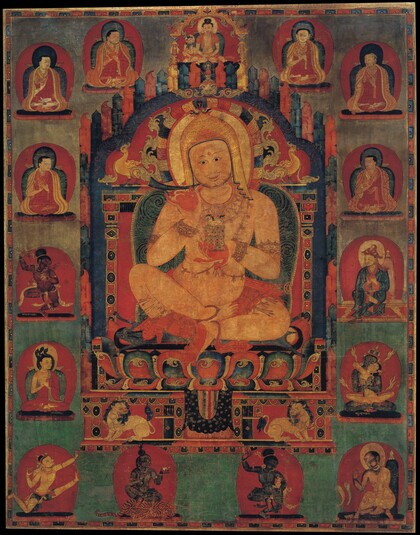
Item: Indian Adept (siddha)
| Origin Location | Tibet |
|---|---|
| Date Range | 1300 - 1399 |
| Lineages | Kagyu and Buddhist |
| Material | Ground Mineral Pigment on Cotton |
| Collection | The Metropolitan Museum of Art |
Classification: Person
Jnanatapa, an Indian siddha, surrounded above by Tibetan lineage teachers and below by the Eight Great Siddhas. (See a Jnanatapa sculpture HAR #4802).
The Eight Great Siddhas are depicted in the bottom half of the painting on the left and right vertical registers. At the middle left is Saraha, brown in colour, in a dancing posture, holding two arrows in the right hand and a vase in the left. Below Saraha is Nagarjuna in the robes of a monk and a hood of three snakes. Below that is Ghantapa, holding a vajra and bell, leaping into the air. Below that is Dombi Heruka, dark in colour, riding a tigress. At the middle right is King Indrabhuti dressed in royal attire. Below that is Padmavajra embracing a consort. Below that is Luipa with two fish displayed in front. Below that is Kukkuripa, dark in colour, dancing, and holding a dog.
There is no Virupa or Lawapa in this system of eight siddhas.
Numbered List:
Saraha Nagarjuna Ghantapa Dombi Heruka Indrabhuti Padmavajra Luipa Kukkaripa
Jeff Watt 6-2006 [updated 12-2024]
Publication: Sacred Visions
Thematic Sets
Subject: Eight Siddhas (Eight Great Adepts)
Subject: Eight Siddhas In One Painting
Collection of The Metropolitan Museum of Art: Main Page
Subject: Greyscale - Figurative & General Composition
Indian Adept: Alternate Central Figure Compositions (for 8 & 84 Mahasiddhas)
Indian Adept: Siddha Appearance Masterworks (Painting)
Indian Adept: Jnanatapa
Indian Adept (Mahasiddha): Painting
Indian Adept: Systems of Mahasiddhas
Indian Adept (Mahasiddha): Painting (Early Period 11th-14th)
Indian Adept: Three Groupings
Exhibition: Mandalas, Mapping the Buddhist Art of Tibet (Teachers)
Painting Style: Minimalism & Minimalist Landscape
Definition: Mahasiddha (Three Meanings of the Term)

